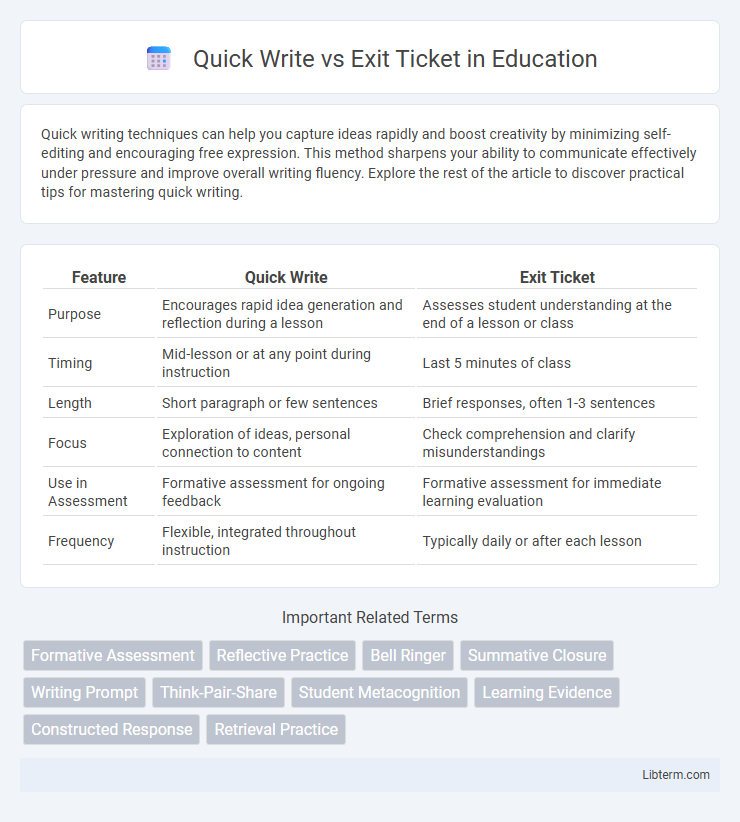Quick writing techniques can help you capture ideas rapidly and boost creativity by minimizing self-editing and encouraging free expression. This method sharpens your ability to communicate effectively under pressure and improve overall writing fluency. Explore the rest of the article to discover practical tips for mastering quick writing.
Table of Comparison
| Feature | Quick Write | Exit Ticket |
|---|---|---|
| Purpose | Encourages rapid idea generation and reflection during a lesson | Assesses student understanding at the end of a lesson or class |
| Timing | Mid-lesson or at any point during instruction | Last 5 minutes of class |
| Length | Short paragraph or few sentences | Brief responses, often 1-3 sentences |
| Focus | Exploration of ideas, personal connection to content | Check comprehension and clarify misunderstandings |
| Use in Assessment | Formative assessment for ongoing feedback | Formative assessment for immediate learning evaluation |
| Frequency | Flexible, integrated throughout instruction | Typically daily or after each lesson |
Introduction to Quick Writes and Exit Tickets
Quick Writes serve as brief, focused writing exercises that prompt students to synthesize thoughts rapidly, enhancing immediate engagement and comprehension. Exit Tickets function as concise assessment tools administered at the end of lessons, allowing educators to gauge student understanding and inform subsequent instruction. Both strategies support formative assessment but differ in timing and purpose within the learning process.
Defining Quick Writes
Quick Writes are brief, focused writing exercises designed to elicit immediate responses and capture students' understanding of a specific topic or prompt. They typically last between 3 to 10 minutes and prioritize spontaneous, unedited ideas to encourage fluency and critical thinking. Unlike Exit Tickets, which assess comprehension at the end of a lesson, Quick Writes serve as formative tools to stimulate reflection and generate ideas during the learning process.
Understanding Exit Tickets
Exit Tickets serve as concise formative assessments allowing educators to gauge student comprehension and identify learning gaps quickly. Unlike Quick Writes, which encourage broader personal expression and idea development, Exit Tickets target specific objectives, delivering immediate feedback on lesson effectiveness. Implementing Exit Tickets regularly enhances targeted instruction and supports timely interventions based on student understanding.
Purpose and Objectives of Quick Writes
Quick Writes serve as brief, focused writing exercises designed to activate prior knowledge, encourage critical thinking, and assess student understanding in real-time. Their purpose centers on promoting immediate engagement and reflection, helping educators gauge comprehension and identify misconceptions early in the lesson. In contrast, Exit Tickets primarily function as summative assessments collected at the end of a lesson to evaluate overall student learning and inform future instruction.
Purpose and Objectives of Exit Tickets
Exit Tickets serve to quickly assess student understanding at the end of a lesson, providing immediate feedback on learning objectives and guiding future instruction. Their primary purpose is to identify areas where students struggle, allowing educators to adjust teaching strategies to meet diverse learning needs. Unlike Quick Writes, which encourage free expression and idea development, Exit Tickets focus on directly measuring comprehension and retention of specific content.
Key Differences: Quick Write vs Exit Ticket
Quick Write involves students writing freely and at length to explore ideas or reflect on learning, fostering creativity and deeper thinking. Exit Ticket requires concise, focused responses summarizing key concepts or answering specific questions, serving as a formative assessment tool. The primary difference lies in Quick Write's open-ended nature versus Exit Ticket's targeted feedback purpose.
When to Use Quick Writes in the Classroom
Quick Writes work best when teachers want to gauge students' immediate understanding or generate ideas before a lesson. They serve as a formative assessment tool to identify gaps in knowledge or spark creativity in subjects like literature or social studies. Implement in the early stages of a class or unit to promote critical thinking and encourage student engagement without time-consuming grading.
When to Implement Exit Tickets
Exit tickets are most effective when used at the end of a lesson to assess student understanding and inform future instruction. Implementing exit tickets helps teachers quickly gauge whether learning objectives were met and identify areas needing reteaching or enrichment. They provide immediate, actionable feedback to tailor upcoming lessons for improved student outcomes.
Benefits of Quick Writes and Exit Tickets
Quick Writes enhance student engagement by encouraging spontaneous, critical thinking and allowing immediate access to individual understanding. Exit Tickets provide clear, formative assessment data for teachers, enabling targeted instruction and timely feedback. Both tools promote reflection and retention, supporting diverse learning styles and fostering continuous academic growth.
Best Practices for Effective Classroom Assessment
Quick Writes offer a valuable formative assessment tool by encouraging students to express understanding through brief, focused writing prompts, promoting critical thinking and immediate feedback. Exit Tickets serve as concise assessments at the end of lessons, allowing teachers to gauge comprehension and inform instructional adjustments efficiently. Implementing both strategies with clear objectives, timely feedback, and alignment with learning outcomes enhances classroom assessment effectiveness and supports student learning progress.
Quick Write Infographic

 libterm.com
libterm.com